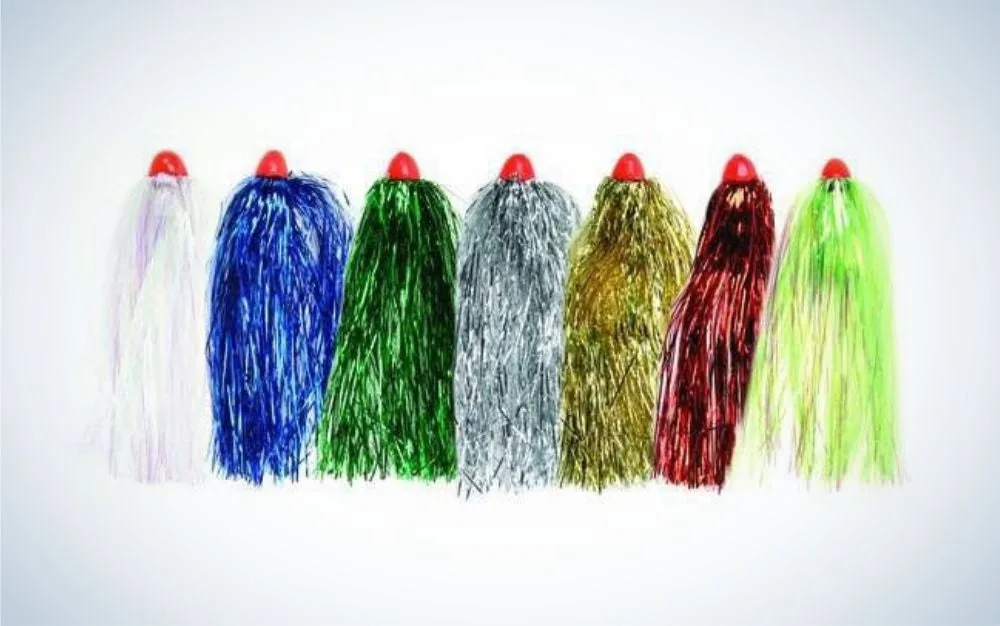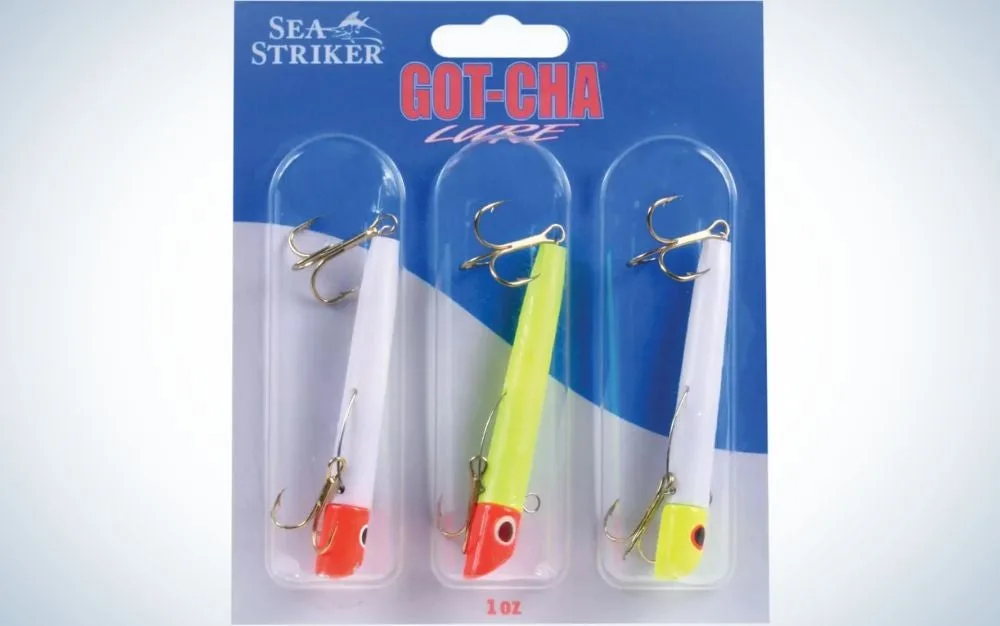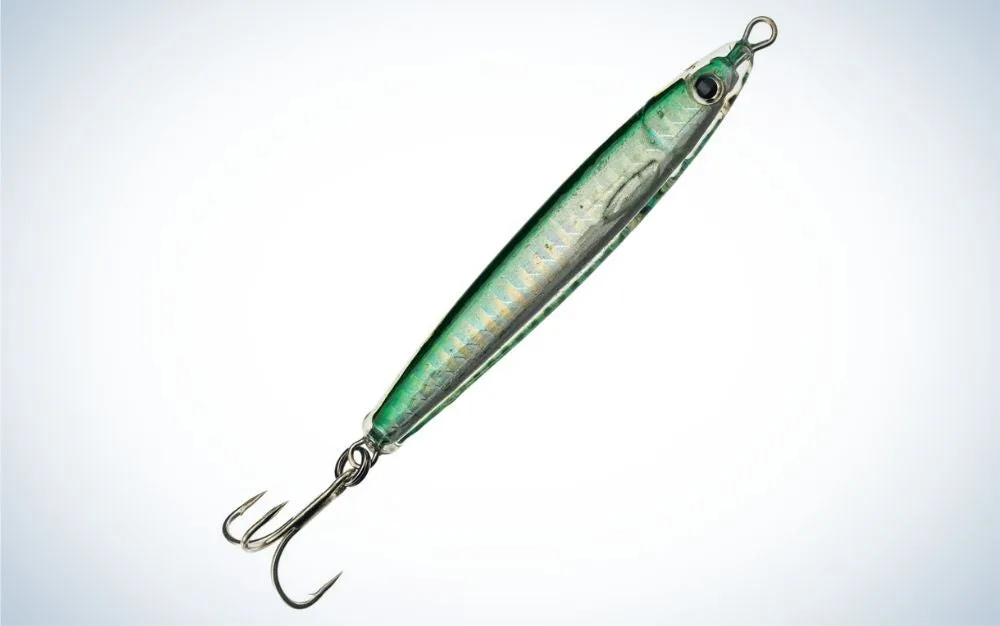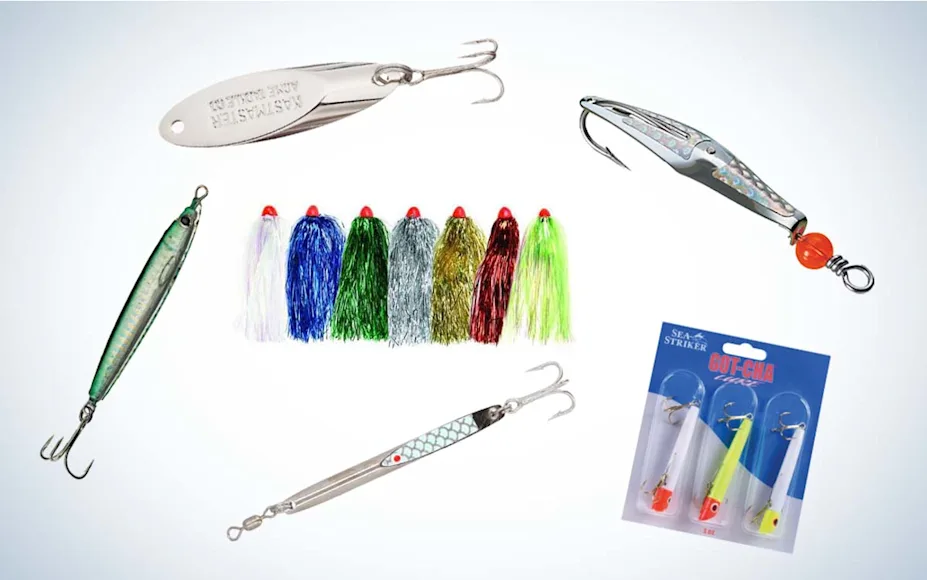_We may earn revenue from the products available on this page and participate in affiliate programs. Learn more ›
_
Best Trolling

Clarkspoon
LEARN MORE
Summary
The Clarkspoon has been around since 1927, and it’s been filling coolers with Spanish mackerel ever since.
Best Overall

Acme Kastmaster
LEARN MORE
Summary
Dense enough that, even in the small sizes, you can fire one a mile and hit that distant school of blitzing fish.
Best Value

Sea Striker Ultra Mylar Duster
LEARN MORE
Summary
Intended for bigger targets, but a few simple tweaks turn this trolling skirt into a Spanish mackerel killer.
From New York to Florida and across the Gulf of Mexico, Spanish mackerel have a cult following. Anglers pile onto piers and jetties when seasonal migrations bring these brawlers close to the beach, while offshore fishermen in the South can catch them practically year-round by trolling inshore reefs and humps. Best of all, unlike their cousins the king mackerel, Spanish mackerel have pure white flesh that has no oily taste. They’re perfect on the grill, but they also make excellent sashimi. If that just made you hungry, you’re in luck, because one of the best attributes of these fish is that, with one of the best lures for Spanish mackerel on the end of your line, they’re pretty easy to catch.
Best Trolling: Clarkspoon
Best Overall: Acme Kastmaster
Best Value: Sea Striker Ultra Mylar Duster
Best Pier Lure: Sea Striker Gotcha Plug
Best Beach Lure: Deadly Dick
Best Bait Match: Hogy Epoxy Jig
Things to Consider Before Buying Spanish Mackerel Lures
Spanish mackerel aren’t very big. A 10-pound specimen would be a giant. The average fish is going to fall in the 1- to 5-pound range, but what these fish lack in size they make up for with voracity and speed. Pin a Spanish on a light-action spinning outfit, and you’re going to hear the drag sizzle. These fish are made of solid muscle, so you’ll want to buy a quality rod and reel that can handle them. If you’re fishing from the beach, an 8- or 9-foot light-action spinning rod is perfect. Some anglers lean on specialty rods built for steelhead for this purpose, as they’re longer like a traditional surf rod, minus the extra weight and stiffness. From a boat where casting distance is less of a factor, any rod will do, but Spanish mackerel are the perfect size for those lighter combos you might normally reserve for freshwater pursuits. With your rod and reel set up, here’s what you’ll need to look for in a lure.
Casting or Trolling Lures
Regardless of whether you’re targeting Spanish mackerel from the beach or a boat, one element of the game remains constant: small lures rule. Spanish mackerel feed on little bait, with forage species like glass minnows, spearing, anchovies, pilchards, and peanut bunker being some of their favorites. This whittles down the pool of hot lures significantly, especially considering that when Spanish mackerel are engaged in a feeding frenzy, if your offering is the right size and flashes just a little bit, it’s going to get hammered. They’re not picky, and while some of the lures commonly cast for Spanish macks work on the troll and vice versa, the crossover is not always constant, so determining your primary method of targeting them will help you figure out which lures are ideal.
Lure Material
It’s very rare to catch just one Spanish mackerel. These are schooling fish, and usually if you find one, you’ve found the motherload. Most commonly, whether off a pier or a few miles offshore, Spanish mackerel give themselves away by creating a ruckus on the surface, slashing through bait schools, airing out, and foaming up the water. But Spanish mackerel, as small as they are, have a nasty set of chompers. Their teeth are razor sharp, which is why it’s never a bad idea to add a short trace of steel bite wire
to the end of your line. Still, you can expect some bite-offs and lure damage, which is why soft-plastic baits aren’t the best choice (unless you’re OK with burning through a few bags during a good bite). Hard-body lures like metal spoons and plastic plugs do the best job of standing up to that wicked maw, though there are a few exceptions that catch Spanish mackerel so effectively, it’s worth replacing them when they get too torn up.
Best Trolling: Clarkspoon
Best Trolling

Why it Made the Cut
The Clarkspoon has been around since 1927. Invented in Florida, this simple piece of metal has been filling coolers with Spanish mackerel ever since.
Key Features
Diamond shape
Strong hook
Anti-twist line-tie eye
Pros
Simple to use
Works with or without being weighted
Cons
Action is muted when trolled on steel leader
Because the Clarkspoon is so light, it’s difficult to cast, especially when dealing with the 2-inch model that Spanish mackerel love. But if you want to learn how to troll for these fish, there’s no better option. Thanks to a swiveling line-tie eye, the Clarkspoon won’t twist your line as it’s wobbling and flashing feverishly behind the boat. They track beautifully at high and low trolling speeds, and you don’t need any special trolling outfits to put one to work. Just tie one on your light spinning rod, send it back 40 to 50 feet and hang on. Unweighted, a Clarkspoon will skip and dance at the surface; rig a cigar-shaped trolling weight a few feet ahead of one and you can get it working almost anywhere in the water column.
Best Overall: Acme Kastmaster
Best Overall

Why it Made the Cut
The Kastmaster is dense, so even in the small sizes that are most appealing to Spanish mackerel, you can fire one a mile and hit that distant school of blitzing fish.
Key features
Precision machined
Highly reflective
Aerodynamic shape
Pros
Casts a mile
Won’t bend or deform
Cons
Often creates line twist
Sometimes Spanish mackerel will feed in the waves right at your feet, but that’s a rare treat. More often, you need to send a lure flying well past the breakers, or a good distance off the pier or jetty, to reach active fish. Enter the Kastmaster. Even in the 2- and 3-inch size, the aerodynamic shape will slice through a stiff onshore breeze and land on target. (For the same reason, we like the Kastmaster for striped bass fishing
). Upon touchdown, reel quickly to get this heavy metal darting and wobbling. To reduce line twist, add a split ring and barrel swivel to the front eye of the lure. This also makes it easier to connect a steel bite wire. One of the biggest advantages of a Kastmaster is that they are practically indestructible—Spanish macks can chomp on it all day and it’s not likely to scratch or tarnish that bright chrome finish. You can also troll a Kastmaster behind the boat and it’ll get smashed.
Best Value: Sea Striker Ultra Mylar Duster
Best Value

Why it Made the Cut
Although the Ultra Mylar Duster is intended for bigger targets, a few simple tweaks turn this trolling skirt into a Spanish mackerel killer.
Key features
Neon head
Highly reflective
Tracks straight
Pros
Affordable
Works at any depth
Cons
Will get destroyed by mackerel teeth eventually
The funny thing about the Duster is that it’s not intended for Spanish mackerel at all. It’s meant to ride on the leader and ramp up flash ahead of a ballyhoo bait being trolled for much larger species like sailfish, mahi-mahi, and tuna. But if you crimp a small hook to your leader and string on a few beads so that hook is positioned at the tail of a Duster, it becomes the perfect Spanish mack trolling lure. The Duster is small, but it packs a ton of metallic flash. The lightly weighted head also gets it riding just below the surface, though with the addition of a trolling weight farther up the leader you can get it swimming as deep as you want. Mylar is also a pretty strong material. It will withstand a lot more hits from sharp mackerel teeth than similar soft-plastic or vinyl trolling lures. However, over time, the Duster’s long, shiny locks will get a buzz cut. But considering a single Duster will only set you back a couple bucks, it’s not that big of a deal. They’re also available in a wide range of colors to match any water conditions and clarity.
Best Pier Lure: Sea Striker Gotcha Plug
Best Pier Lure

Why it Made the Cut
The Gotcha has been a staple for Spanish mackerel on piers and jetties from Pensacola to Hatteras for decades.
Key features
Lead head
Through-wired construction
Streamlined body
Pros
Casts very far
Inexpensive
Cons
Takes a bit of practice to work properly
If you want to learn how to catch Spanish mackerel from a pier like the pros, pay attention to what the seasoned vets are casting. Quite often, it’s a Gotcha. This oddball lure is part plug and part jig, and it’s downright deadly. With a painted lead head and plastic tube body, the Gotcha is aerodynamic, so you can really let one fly. The magic comes from the sloped face, which deflects water. If you just cast and reel, the Gotcha has practically no action. But when you pop the rod tip during the retrieve, that head makes the lure dart erratically from side to side. Something about this action drives Spanish mackerel wild, and the tough construction helps the lure stand up to mack attack after mack attack. Even if a few Gotchas do get clipped off, they cost a bit less than some metals and similar hard plugs, so it won’t sting quite as badly.
Best Beach Lure: Deadly Dick
Best Beach Lure

Why it Made the Cut
The Deadly Dick has been around for decades, and while it works great when vertically jigged, it also outcasts many other lures from the beach.
Key features
Slim body
Swivel attachment for anti-twisting
Holographic accents
Pros
Great for distance casting
Perfect imitator of very small baitfish
Cons
Decals will get shredded by mackerel teeth
Spanish mackerel gorge on rain bait, which is a catch-all term for a wide variety of tiny forage species. When little morsels like glass minnows and anchovies are grouped in big shoals, they often dimple the surface like rain drops, hence the name. The issue with rain bait, especially when you’re fishing from land, is finding a lure small enough to match its size and slender profile, but also offer some decent casting distance. The Deadly Dick fits the bill. Although slim, this metal slab spoon is heavy. Its unique angles also give it some aerodynamic advantages. On a light-tackle outfit, even if a breeze kicks up, you can launch a Deadly Dick like a bullet. Once it hits the water, wait a few seconds before beginning your retrieve. A Deadly Dick flutters seductively on the fall, and Spanish will often grab one as it descends. When you do start cranking, don’t be afraid to ramp up the speed. Deadly Dicks are particularly attractive to mackerel when they’re burning just under the surface and occasionally jumping clear of the water and splashing back down.
Best Bait Match: Hogy Epoxy Jig
Best Bait Match

Why it Made the Cut
A relative newcomer to tackle shops, the Hogy Epoxy Jig is arguably one of the most visually accurate representations of the forage species Spanish mackerel devour.
Key features
Lifelike baitfish finish
Tough resin body
Premium hardware
Pros
Works well cast or trolled
Most anatomically accurate baitfish representation
Cons
Significantly more expensive than similar lures
With the Epoxy Jig, Hogy has beautifully married design features that hadn’t been put together previously. The lifelike finish is more akin to what you’d expect to find on swimbaits and soft-plastics, while the dense, compact body design mirrors that of classic metal lures. To create this tough-as-nails jig, Hogy puts an anatomically accurate foil insert around a lead core, and then encases everything in a thick epoxy shell. They also use premium hooks and hardware, plus these baits are solidly through-wired. Of course, all this engineering will cost you. Epoxy Jigs will set you back $11 or more each, which makes it painful when a Spanish mackerel bites one off (so don’t skip the steel wire when using these). However, Epoxy Jigs also have incredible wobbling and darting action, you can launch one into next week, and the available colors let you match any local forage or water conditions that present themselves.
How We Made Our Picks
The products we picked have been Spanish mackerel favorites throughout the decades we’ve been fishing. The Clarkspoon has been around since 1927. Acme started making spoons back in the 1950s. This line of thinking works best for Spanish mackerel. If you stick to the classics, you’ll be good. These fish are small, but they’re rough with lures. The ones that can handle it will stick around.
That said, there’s still some ‘innovation’ to see in Spanish mackerel lures. Hogy’s Epoxy Jig upped the standard by better matching the baitfish Spanish mackerel love to prey on. Sea Striker’s Ultra Mylar Duster is meant for bigger species like sailfish, mahi-mahi, or tuna, but with a little know-how, it’s perfect for trolling for Spanish macks.
That said, these were the main considerations in our final decisions:
Price: How many times have I said it already? Spanish mackerel are tough on lures. They’ve got razor sharp teeth, a dense build, and hard-fighting nature. Even with steel bite wire as a leader, you’ll lose a lure or two. Just consider the price.
Durability: Still, you can make sure your lures are built to handle those hard bites. If a mack attack takes a lure off your line, fine. If the lure itself can’t handle the heat, not a good option.
Size: Spanish mackerels are not big fish, so a Spanish mackerel lure will need to match that. A lure that’s 2- or 3-inches is the sweet spot.
FAQs
Q: How much do lures for Spanish mackerel cost?
Around $10 is the sweet spot. If you want a little more baitfish believability, like on the Epoxy Jig, $10 is the price floor. But on the whole, Spanish mackerel are not picky, so the lures on this list are uncomplicated and well priced.
Q: Can you catch Spanish mackerel from the beach?
Absolutely! In fact, it’s quite easy if you’ve got calm surf in front of you. When the water is calm, you can easily look out and see if there’s a commotion of baitfish on the surface, a good indicator that your Spanish mackerels are feeding. All you need to do then is move to the school and get your cast right.
Q: What lure is best for Spanish mackerel?
The main rule: Small lures rule. These are small fish feeding on even smaller bait. After that, it depends heavily on if you’re casting or trolling. Again, these fish aren’t picky with lures. So when you’re casting, you want something that’ll cast well at small sizes, something dense. If you’re trolling, all they want is nice movement and a little bit of flash. They’ll hit your lure, don’t worry.
Final Thoughts
If you take anything away from this story, let it be this: The best Spanish mackerel lures need to be tough. These fish are small, but they’re solid, explosive muscle. It’s what makes them so fun to catch, but it means they’re going to beat up your lure. Get some steel bite wire
, one of the lures on this list, and strong lightweight setup and, trust me, you’ll have the time of your life fishing Spanish mackerel.






